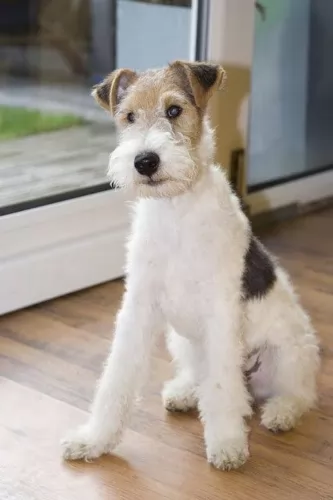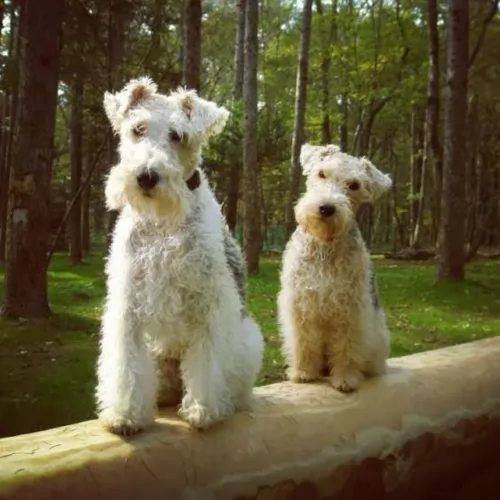 Petzlover
PetzloverVikhan Sheepdog is originated from Pakistan but Wire Fox Terrier is originated from United Kingdom. Vikhan Sheepdog may grow 29 cm / 12 inches higher than Wire Fox Terrier. Vikhan Sheepdog may weigh 38 kg / 84 pounds more than Wire Fox Terrier. Vikhan Sheepdog may live 5 years less than Wire Fox Terrier. Vikhan Sheepdog may have more litter size than Wire Fox Terrier. Vikhan Sheepdog requires High Maintenance. But Wire Fox Terrier requires Moderate Maintenance
The Vikhan Dog is a rare breed that very little is known about. It is not sanctioned by any breed club or kennel club. The breed originally came from Pakistan in the North-west Frontier Province near the Indian border, in the Chitral region and the state of Himacchal Pradesh. For the most part Pakistan is credited with the development of the breed. They originally guarded livestock and hunting leopard. He is fast and fierce. The breed is bonded to the livestock when they are very young and instinctually guard them for the rest of their life. They do not herd them, they blend into the flock and watch for outsiders.
They confront strangers and predators with aggressive displays and vocal intimidation. If this does not work, it will attack and drive them off. They are even known for luring coyotes into a trap with food so that they can hunt them.
 The wire fox terrier was developed in England by fox hunting enthusiasts. They wanted a feisty dog that could chase foxes down their burrows.
The wire fox terrier was developed in England by fox hunting enthusiasts. They wanted a feisty dog that could chase foxes down their burrows.
It is thought that the dog descended from the rough-coated black and tan working terriers of Wales.
The dog wasn’t popular as a pet until the 1930s when its appearance in certain films gave it a popularity-boost.
The Vikhan Sheepdog is a large working breed that is lean, muscular and aggressive. He is immensely intelligent and fearless. He has a thick coat in solid brown, red, fawn or black. There are also multi-colored and spotted versions as well. They are related to the other regional Molossers and are sometimes called the giant Rough Collie. They are faster than they are strong. All Molossers are solid, large and share the same ancestor.
They typically have short, muscular necks and broad but short muzzles. They have heavy bones, wrinkles and pendant ears. With well-muscled legs and wide chests, the Molossers include the mastiffs and bully breeds and all other breeds that come from those groups. Molossers are either flock guardians or home guardians. The Vikhan Sheepdog is a flock guardian
 The Wire Fox Terrier is a sturdy, medium-sized dog that weighs between 7 and 9kg and stands between 35 and 39cm at the withers.
The Wire Fox Terrier is a sturdy, medium-sized dog that weighs between 7 and 9kg and stands between 35 and 39cm at the withers.
The dog’s double coat is essentially white with brown or tan markings and can be medium length and wiry, tending to be curly too.
He is a light shedder. The face is long, without much shape and eyes appear to be fairly close together. The ears are fairly small and they fold forward toward the cheeks. The tail is docked and is held high.
This really is an intelligent dog and can’t tolerate being bored. It’s essentially a companion dog too and doesn't want to be separated from his owners for too long.
As a companion dog he is going to want a lot of attention. They’re independent and strong-willed and will benefit from training and socialization.
They are great around children but they do need to be supervised as they are inclined to nip, especially when highly excited. They also bark quite a bit and the owner might have to do something to stop this yapping, especially when the dog is bored.
 The Wire Fox Terrier is such a canine friend, ready to be with you no matter what you’re doing. They are social dogs and love being involved with their human companions.
The Wire Fox Terrier is such a canine friend, ready to be with you no matter what you’re doing. They are social dogs and love being involved with their human companions.
He is independent but still social and enthusiastic and you can describe him as the ideal family dog.
He is a bundle of energy, and when you bring him into your home, you’re going to get a family member who is playful, joyful, loving and loyal – your very best friend.
Because this is a rare breed having lived in isolation for centuries, little is known or documented about their health issues. However being a large Molosser, they face some of the same health challenges as all large dogs. These include
• Bloat – when the internal organs of the intestinal system are knotted or inverted. Without immediate attention it causes death under all circumstances. You need to get the dog to a vet as soon as possible.
• Hip Dysplasia – Can cause lameness in hind legs and/or arthritis. Can be treated.
• Elbow Dysplasia – Can cause lameness in the front legs and/or arthritis. Can be treated.
 These are healthy dogs, and if you get your dog from a responsible breeder, he will have been checked for health conditions such as cataracts, hip dysplasia, and luxating patellas.
These are healthy dogs, and if you get your dog from a responsible breeder, he will have been checked for health conditions such as cataracts, hip dysplasia, and luxating patellas.
Cataracts are a problem with the lens of the eye. The lens focuses light and it should be crystal clear. A cataract obscures vision. Sometimes the cataract can be very small but other times it can grow to the size of the lens and then it can cause blindness.
Most times, dogs with cataracts can still see, and even though a dog may experience some confusion with a cataract, they don’t hurt the dog. They don’t go away on their own and will need to be removed surgically. If you see your dog has a cataract, consult your vet to get their opinion on the matter.
Your dog may be licking and scratching a lot and it may just be that your dog has a frustrating and irritating skin problem. This itching isn’t a disease but rather a cause of some disease.
There could be so many things that are causing your pet to scratch and it could be a skin disease, parasites or allergies. It can be terrible seeing the frustration it causes your pet and he will certainly need to see the vet.
1Feeding the puppy – due to the risk of bloat, don’t overfeed and don’t feed large meals before or after exercise. Also don’t feed too high protein since the puppies grow so fast and it can cause bone injuries. Feed 3-4 x day.
2.Feeding the adult - due to the risk of bloat, don’t overfeed and don’t feed large meals before or after exercise. feed 2 X day
4. Games and Exercises Although large dogs they are surprisingly good at agility, they need a lot of exercise and long walks.
 This dog will need to be brushed regularly. Some people hand-strip their dogs. Most people prefer just to take their pets to a professional groomer to have them professionally clipped. The groomers will simultaneously clip his nails, clean the inside of his ears and also clean his teeth.
This dog will need to be brushed regularly. Some people hand-strip their dogs. Most people prefer just to take their pets to a professional groomer to have them professionally clipped. The groomers will simultaneously clip his nails, clean the inside of his ears and also clean his teeth.
The Wire Fox Terrier will expect you to supply him with high-quality dog food if you opt to use commercially manufactured dog food. These foods can be wonderfully convenient but you want the food to be packed with natural ingredients and be high in vitamins and minerals.
Any diet should also be appropriate to the dog’s age, his size, and his activity levels. Some homemade foods can also be a treat but this needs to be simple with no heavy spicing. Things such as boiled chicken, brown rice and vegetables can be an excellent choice.